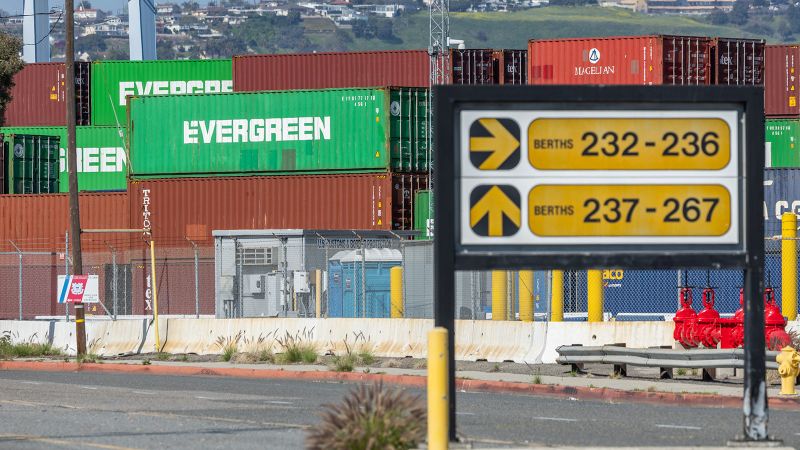The ongoing impact of President Donald Trump’s aggressive policy decisions is under intense scrutiny as the U.S. economy appears to have taken a significant downturn at the start of the year. Analysts are projecting that the initial quarter of 2023 could witness the worst economic performance since the emergence of the Covid-19 pandemic, chiefly driven by uncertainties surrounding the hefty tariffs enacted by the administration. The economic climate has left both consumers and businesses grappling with anxiety about the repercussions of Trump’s policies.
On Wednesday at 8:30 AM ET, the Commerce Department is anticipated to unveil its preliminary estimate regarding the first-quarter gross domestic product (GDP). This pivotal figure serves as the broadest assessment of economic output and will provide crucial insights into how Trump’s extensive economic strategy is influencing the U.S. economy. This announcement is particularly timely, as it follows closely behind the administration’s 100th day in office.
Experts predict the GDP growth rate for the first quarter will be around 0.8% on an annualized basis after adjusting for both inflation and the effects of seasonal variations. If accurate, this would mark the weakest growth since mid-2022, as forecasted by FactSet, a financial data firm. Contrarily, the Federal Reserve Bank of Atlanta has projected a more alarming contraction, estimating a shrinkage of 2.7%, which would signify the worst quarterly performance since the middle of the past decade.
The sluggishness in GDP is potentially attributable to an uptick in imports, stimulated by American consumers and businesses rushing to purchase goods before the imposition of new tariffs. This surge in imports significantly impacts GDP figures since higher imports contribute negatively to economic output. Factors such as severe winter weather also compounded weaker consumer spending early on in the quarter, as shoppers opted to stay home. Additionally, the climate of uncertainty surrounding Trump’s policies has led companies to pause investments.
Nathan Sheets, Chief Economist at Citigroup, expressed that amidst the noise of various external factors, there is palpable concern over how the tariffs could unfavorably affect both the broader economy and market sentiment. The administration’s erratic approach toward tariffs has raised alarms, especially given its aims to rectify a growing trade deficit that has worsened in recent months, despite claims of a “national emergency.”
So far, Trump has instituted substantial tariffs on an array of goods, including a 25% levy on aluminum and steel, and a staggering 145% on imports from China. Additionally, a 25% tariff has been placed on non-compliant goods from Mexico and Canada, alongside a 10% baseline tariff on all imports. This month alone, an intensified tariff hike was fleetingly approved but subsequently delayed until July, showcasing the volatility of the administration’s economic tactics.
In retaliation, China has escalated its tariffs on U.S. imports to an imposing 125%. This trade conflict has made the economic landscape tenuous and complicated for all involved parties, including the European Union and Canada, both of which have vowed to counter the U.S. tariff measures.
Amidst this chaos, America’s trade deficit reached a record high by late March 2023, swelling by $14 billion to a staggering $162 billion, according to preliminary Census Bureau data. This follows alarming statistics from earlier in the year, where the trade deficit jumped 34% in January to $130.6 billion and recorded $122.7 billion in February.
On the consumer front, it appears that spending behaviors have shifted significantly, with signs of deterioration during the initial phases of 2023 attributed to not only the economic climate but also harsh winter conditions and wildfires impacting areas like Los Angeles. Notably, retail sales plunged by 0.9% in January, signaling the potential fragility of consumer confidence. Conversely, March saw a remarkable surge in retail sales as consumers attempted to preemptively purchase goods before tariff implementations; however, analysts warn that this uptick might only be a temporary phenomenon.
The sentiment among businesses also echoed consumer concerns as recent assessments revealed unease within the manufacturing and services sectors, resulting in cautious business spending. Non-defense capital goods orders—a critical indicator of business investment—showed signs of stagnation, reflecting a 0.3% drop in February, followed by a marginal increase of just 0.1% in March.
All of these elements coalesce to suggest a complex and uncertain economic landscape fueled by the ongoing ramifications of Trump’s tariff policies. As the development continues, more updates are anticipated.



